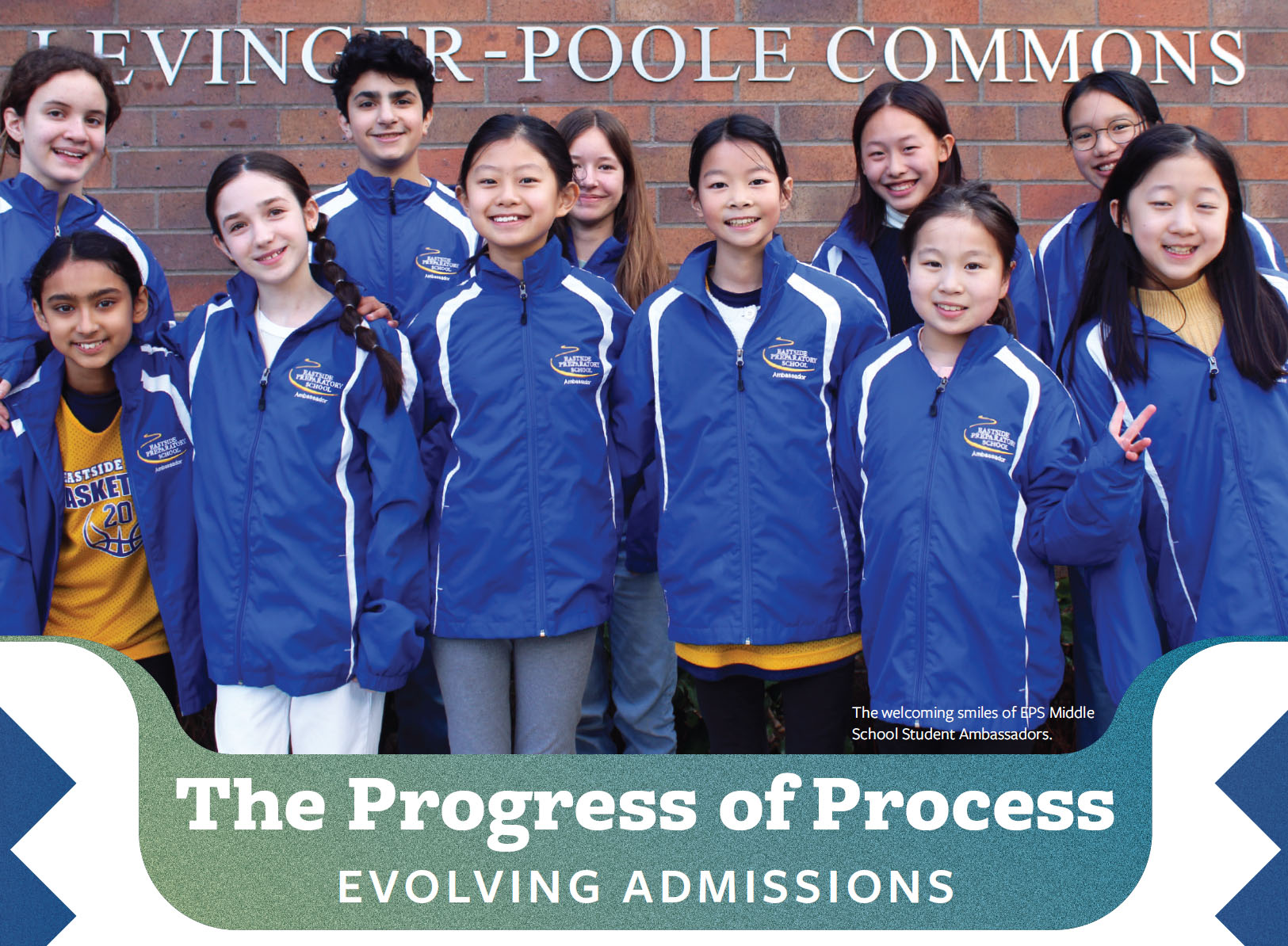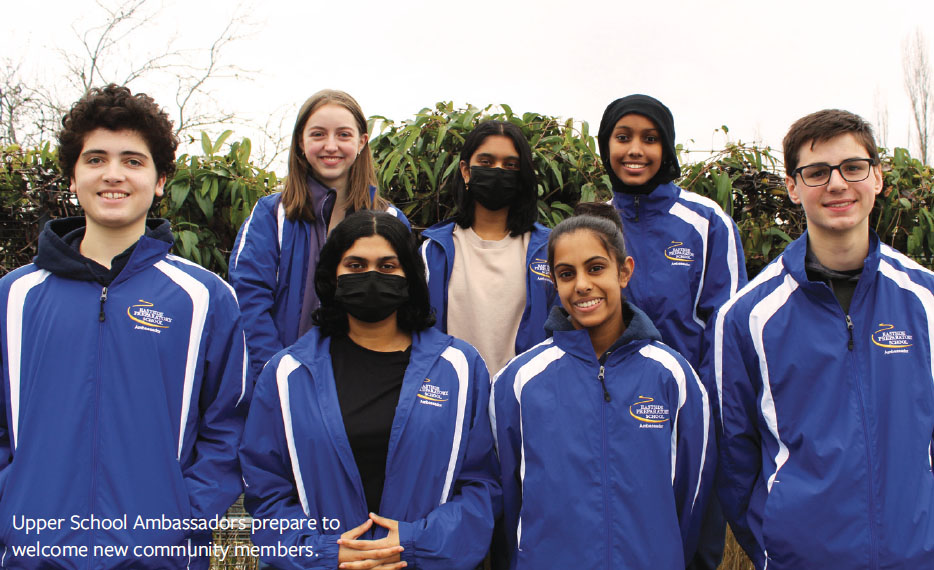
By Cheryl Schenk Miller, Director of Enrollment Management
Dr. Terry Macaluso has often been quoted that the two most important decisions that we make as a school community are who we employ and who we admit. The community members who comprise Eastside Prep, and the culture they sustain and create daily, are what make us EPS. Through twenty years of growth as a school community, we have experienced concurrent growth of our applications, presenting challenges for applicant families and the EPS community alike: We want to make the best possible decisions, informed by the best possible information. We want to set the tone in admissions for what families can expect from the entire EPS community after they enroll. And we want to keep our process personalized and connected while also operating at scale. As a result, we made two big changes to our admissions process for the 2022-2023 admissions season. These changes were designed to support our goals of incorporating student voice in every application, increasing equity, and simplifying the admissions process.
AUTHENTICITY AND EFFICIENCY: ADMISSIONS PREVIEW EVENTS
Before 2020, families would have typically visited campus four different times before applications were reviewed: an open house, a weekday tour, a parent/guardian interview, and a student weekday visit. When we brought these events online by necessity in 2020, we learned so
much about what could be offered virtually and what we missed when in-person visits were temporarily impossible.
Virtual spaces are great for disseminating information, so we focused on making the EPS website and Ravenna information comprehensive and exhaustive. We scheduled “Office Hours” to meet applicant families online and unpack the elements of the application process. We
recommitted to having moved our parent/guardian interviews online (which had previously often necessitated the arrival of two adults from two different locations in two different vehicles for one thirty-minute meeting), and continued to offer these on weekdays, evenings, and weekends thanks to the ease of connecting online.
| KEY BENEFITS IN AN EPS EDUCATION: |
|
By contrast, we wanted our visit programs to help families experience elements best accomplished in-person: authentic connections with a wide range of community members, engagement with how we do school collaboratively at EPS, and exploration of campus spaces. With these goals in mind, we set out to revamp our in-person visit model.
With a growing number of applications, hosting open house programs and in-person school-day visits—including tours and classroom experiences—necessitated that we either make our visit events larger, or stop hosting them entirely. Neither one of those options reflected our culture of knowing students individually and connecting with families conversationally. We decided to shift away from the model of hosting informational open houses followed by school-day visits, instead consolidating the best parts of all visit experiences into a new series of Preview Events. Through a welcome from Head of School-elect Sam Uzwack, then a quick screening of a video introducing the history of EPS, we set the tone. By sharing key benefits in an EPS education, and through community members present at the event introducing themselves, we showcased our culture, diversity, and humor. As students enjoyed two mini classes taught by a pair of EPS faculty members, parents and guardians could ask our community member panel anything. The opportunity to further connect with student ambassadors and explore campus, as well as to engage conversations with faculty and leadership team members, rounded out the experience.
“The goal of the Admissions Team this year was to make the process inclusive and equitable. Combining the previous Open House, tour, and mock classes into one evening or weekend event means less time away from school and work for families,” remarks Jennifer Chi, Admissions Communications Coordinator.
We still needed to solve for how to serve families out-of-area and those who would be unable to visit during any of the eight Preview Event timeframes. We hosted one online version of the preview events that featured faculty-hosted mini classes followed by live Q&A with admissions staff and student ambassadors. For those families who entered the admissions application process later in the season, we offered “Get to Know EPS” virtual events featuring a video screening, key themes of the EPS experience, and live Q&A with admissions staff and student ambassadors.
HEARING EVERY STUDENT’S VOICE: THE STUDENT ONLINE ASSESSMENT
In each EPS classroom, our teachers value the perspectives and experiences each student brings. While we had been able to showcase this classroom culture through mini classes in the visit experience, we had a limited window into applicants’ thoughts and ideas in the group setting of a mini class. To gain unique insights about individual students, we interviewed about one-third of our applicant pool in twenty-minute student interviews, primarily those applying to Upper School (along with students applying from out-of-area and thus unable to visit EPS in person). Members of our faculty would ask a set of application questions and transcribe students’ responses, also taking notes about students’ questions regarding EPS. This interview transcription would appear in the student application. We would often get feedback from faculty interviewers about the difficulty in gauging authentic student voices in the interviews. Some interviewers noted that their student interviewee may have been nervous because of talking with an adult who was new to them, or who had very different academic and personal interests from them. Others reported that the student seemed to be reciting a response to the question. What could we do differently to interview both Middle School and Upper School applicants, keep our interview question themes consistent, and help students be more comfortable while providing their responses?
 The Admissions Team brainstormed throughout the spring and began to seek a new method for conducting interviews. “We wanted to find a way to get more of the students’ voices, so we started researching interview platforms that would harness video responses. We found Kira Talent to have the best integrated platform for what we wanted to do,” reports Jeff Sternitzky, Campus Ambassador, who assessed options
The Admissions Team brainstormed throughout the spring and began to seek a new method for conducting interviews. “We wanted to find a way to get more of the students’ voices, so we started researching interview platforms that would harness video responses. We found Kira Talent to have the best integrated platform for what we wanted to do,” reports Jeff Sternitzky, Campus Ambassador, who assessed options
along with fellow team members. While the Kira Talent system is uniquely designed for educational institutions, only a handful of K-12 schools have adopted the tool thus far, which is more common among college and university admissions processes.
We began our process with the Kira implementation team by sharing the values that our admissions committees had reflected upon and centered in the admissions process earlier last year. From these values, we crafted together sets of questions around each theme, and these questions were asked of each applicant student. We wanted to gain a sense for not only how a student would respond when speaking
their answers, but also when writing one of their answers. We already valued the in-the-moment writing sample we were able to review through SSAT or ISEE, and the Kira platform has provided a great opportunity to craft our own written response prompt. We have also been able to provide additional time to students whose families indicate that they should be receiving time-and-a-half or double time on their written assessments.
| MIDDLE SCHOOL | UPPER SCHOOL |
|
|
Through Kira, we’ve been able to hear directly from students about the areas we value most in our EPS students, and to imagine how they will cultivate their own curiosities and collaborate with others during their time at Eastside Prep.
With the recent changes to our admissions process, we are confident that families are more informed about the unique value of an EPS education, and that we have gained clear, direct access to students’ unique personalities and interests. With an innovative spirit, we look forward to reviewing what we’ve learned from these admissions process changes after enrolling our new students and families. As successful as this approach was, there is always fine tuning to do; 2023-2024 will give us the opportunity to make further refinements.

